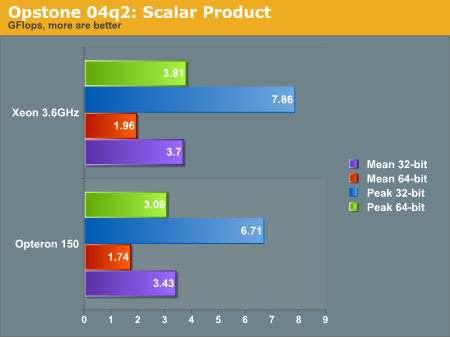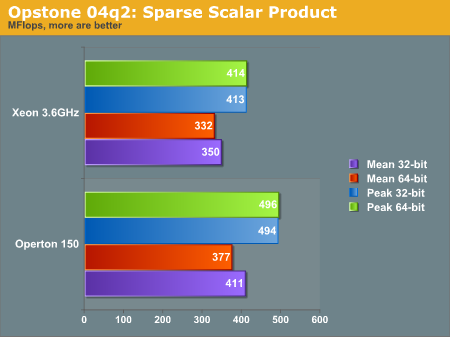Linux Shootout: Opteron 150 vs. Xeon 3.6 Nocona
by Kristopher Kubicki on August 12, 2004 2:35 PM EST- Posted in
- Linux
Opstone
Since our use of Ubench in the previous article clearly infuriated many people, we are going to kick that benchmark to the side for the time being until we can decide a better way to implement it.
In the meantime, a reader suggested we give Blue Sail Software's Opstone benchmarks a try. In this portion of the review, we will use their precompiled optimized binaries of the Scalar Product (SP) and Sparce Scalar Product (SSP) benchmark. The SP benchmark is explained by the author:
"The 'SP' benchmark calculates the scalar product (dot product) of 2 vectors ranging in size from 16 elements to 1048576 elements for both single and double-precision floats. Although the Gflops/sec. for every vector length is recorded (in the resulting output log file), the average of all these values is reported. This benchmark is indicative of the performance of many raw floating-point data processing apps (movie format conversion, MP3 extraction, etc.)"
Note that we ran the P4 optimized binaries on the Nocona, which did not provide x86-64 enhancements. Running the AMD64 binaries on the Xeon yielded poor results. The P4 Opstone binaries are the only 32-bit binaries used in this analysis.

Below is the SSP benchmark, as explained by the author:
"The 'ssp' benchmark also calculates the scalar product of 2 vectors, except that these vectors are sparsely populated (only the non-zero value elements are stored) ranging from a 'loading factor' (non-zero/zero elements) of 0.000001 to 0.01 for both single and double-precision floats. Since the data is not contiguous in memory, the performance is much lower than regular 'sp' and is measured in Mflops/sec. There is not much difference in performance between different loading factors as this benchmark really challenges the ability of the processor to perform short bursts of calculations coupled with lots of conditional testing. It is this reason that the P4 with its longer pipeline does not generally perform as well as the Athlon64. This benchmark is indicative of the performance of many 3D games as the processing is similar (short bursts of calculations with numerous conditional testing)"

There is a general distrust of synthetic benchmarks, so take this portion of the analysis only with a grain of salt. We see a tale of two processors in these graphs; generally the Xeon performs better in the raw operation SP benchmark, while the Opteron performs better in the condition testing SSP benchmark. We would be lead to believe the Intel processor does content integer content creation better than the Opteron, and visa versa with floating point applications. However as we see in the rest of the review, this is not always the case.










92 Comments
View All Comments
Adul - Friday, August 13, 2004 - link
prd00My understanding is the Nocona 3.6 is the same care os the P4 3.6F. Cache size and all. There is no L3 cache on this chip as far as I know of yet.
from page 1
AMD Opteron 150 (130nm, 2.4GHz, 1MB L2 Cache)
Intel Xeon 3.6GHz (90nm, 1MB L2 Cache)
prd00 - Friday, August 13, 2004 - link
Hmm... #68, that's nice.. I would also like Apache server performance as well, as this one is server CPU shootout. Try to reconstruct a page request response benchmark. kind like the one that used in Opteron review or in AcesHardware. Also, please check the scalability when adding second and 3rd/4th processor. how many percent can we gain over the single one.BTW, Kris.. in my opinion, Nocona 3.6 is not comparable to P4 3.6F, because Nocona 3.6 is way faster than 3.6F. It is much more comparable to P4 3.6EE than 3.6F vanilla. I think Intel will release a new 3.6F with vanilla P4 flavor when it is re-released as plain a plain one. So, I guess, 3.6EE is not comparable to A64 3500+ in many ways, as P3 3.4EE is comparable to AFX-53.
DrMrLordX - Friday, August 13, 2004 - link
Good review. This one was definitely thoroughly explained and well-thought-out.I'd like to see the 3800+ put through the paces next, but eh, you guys deserve a rest *)
Locutus4657 - Friday, August 13, 2004 - link
Good job Kris, you did a much better job this time! I guess the first article must really have been a learning experience! But that's what life is all about. So keep up the good work, and I look forward to reading more of your reviews.Arias74 - Friday, August 13, 2004 - link
One last comment as well, and then I'll shut up.I was wondering what the possibility of using Apache for benchmarking in future reviews? Just a thought...
Salvador
Arias74 - Friday, August 13, 2004 - link
I also posted after reading the first article, so I figure I may as well do so again.I'm still a little confused why KK still thinks that a 3.6GHz P4 will be marketed against a 3500+ A64. They do not occupy the same space, price-wise. If you're looking at a 3500 in the name, even Intel realizes that you can't judge by numbers alone, based on the fact that they are moving to an arbitrary naming convention for their processors. The only way to compare the two different product lines is by price, because that is the only constant. So, if the 3.6GHz P4 is the highest priced desktop cpu, then you would have to compare that to AMD's highest price.
For example, if you have 2 systems in the store side-by-side, and one was priced $500 more than the other, wouldn't you assume that the higher priced item would be that much better, hence the higher price tag? Especially nowadays when $1000 can get you a very capable system, $500 is a huge price difference.
Basically, all I'm saying is that it is faulty reasoning to assume that a 3.6GHz Intel cpu will be marketed against a 3500+ Amd A64 cpu. Heck, even AMD doesn't know how to market their own Semprons... apparently, a Sempron 2800+ is only equal to an AXP 2400+ in terms of performance... very weird and wacky stuff!
Salvador
Zebo - Friday, August 13, 2004 - link
Good job, Kris!As far as the chips used...These are very much in compitition with one another. Around the same price and "the best workstation processor" of the respective competing companies. Best vs. best and price. What else is there?
You still need to dump the old article... or at least get rid of the hyperbolye in the conclusion.
AnnoyedGrunt - Thursday, August 12, 2004 - link
T8000, it is interesting how you consider this second review biased, even though many people had pointed out legitimate problems with the first one.You bring up a good point about HT though. Even though it helps in some cases, it hurts in many others. How much of a selling point is it in that case?
I was impressed with both the constructive criticism of the readers and the profesionalism of Kris's responses in this whole affair. Very nice job on this follow-up review. Hopefully, more updates will follow as more 64-bit programs become available.
-D'oh!
Topnikko - Thursday, August 12, 2004 - link
Nice job on this piece, Kris. I like the way you handle criticism. I think it's fairly obvious to you and everyone else that if the Opteron is capable of such a showing in a UP configuration, the Xeon doesn't have a snowball's chance in hell of outperforming the Opteron in multiprocessor configs. If you do decide to write an article comparing multiprocessor machines it'll be down-right ugly for Intel.drewintheav - Thursday, August 12, 2004 - link
Kris you are a w e s o m e !!!!!!